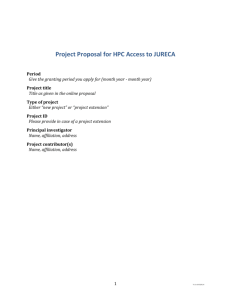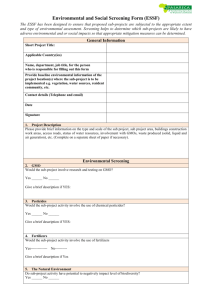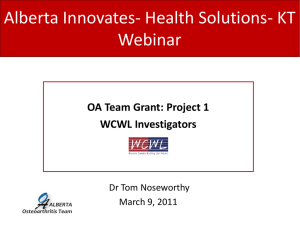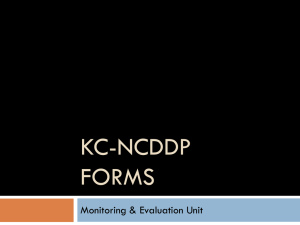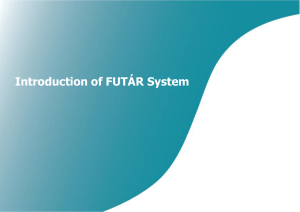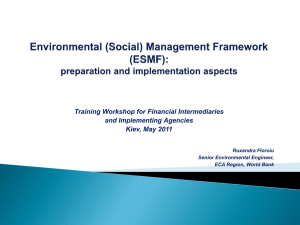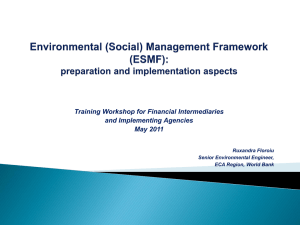pdw ncddp roll out
advertisement
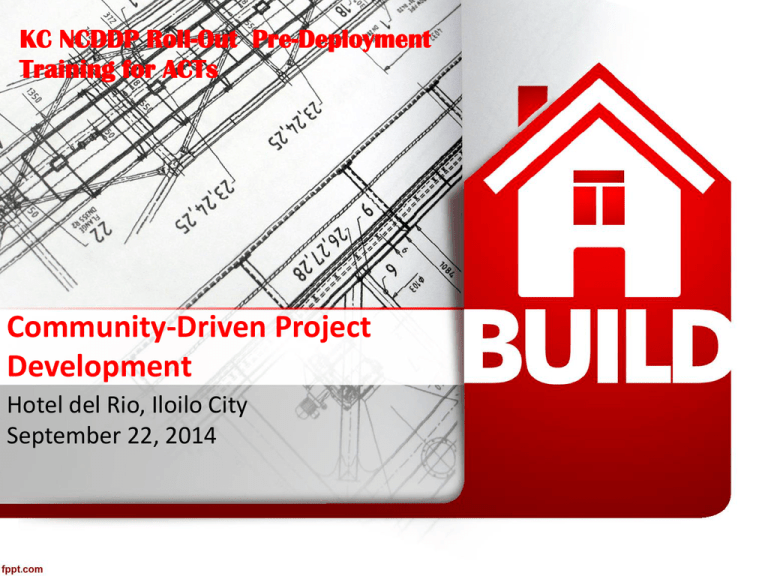
KC NCDDP Roll-Out Pre-Deployment Training for ACTs Community-Driven Project Development Hotel del Rio, Iloilo City September 22, 2014 PROJECT DEVELOPMENT Kalahi CIDSS Objective • Reduce Poverty • Improve Local Governance • Empower Communities PROJECT DEVELOPMENT What can be funded by KC-NCDDP? SUB-PROJECT CATEGORY AND SUB-PROJECT TYPE SUB-PROJECT CATEGORY 1. Basic Social Services SUB-PROJECT TYPE a. b. c. d. e. f. g. 2. Basic Access Infrastructure a. b. c. Water System (Level 1 and II) Elementary School Building High School Building Day Care Center Health Station Electrification (on-grid, offgrid and renewable energy) Tribal Housing/Shelter Barangay Road Foot/Small Bridges/ Spillway/Overflow Access/Footpath (Tirepath, pathwalk, foot trail) SUB-PROJECT CATEGORY SUB-PROJECT TYPE 3. Community Production & Economic Support a. b. c. d. Community Enterprise Pre/Post Harvest Facility Small Scale Irrigation Multi-use Bldg./Facility 4. Environmental Protection and Conservation a. b. c. d. e. f. Drainage System River/Flood Control Seawall Soil/Slope protection Environment Conservation Sanitation and Solid Waste Management 5. Skills Training and Capability Building PROJECT DEVELOPMENT What can be funded by KC-NCDDP other than regular SPs? • Repair of rural and local roads, and Repair/reconstruction of small bridges (maximum span of up to 15m). • Backfill, reshaping and landscaping of areas affected by erosion • Repair of existing riverbank protection systems and earthfill dykes up to 5m height if supervised by a qualified engineer. PROJECT DEVELOPMENT What can be funded by KC-NCDDP? • Construction of temporary bypass roads up to 500 m length, if not located in sensitive habitats and land acquisition is needed and bypasses are completely removed and the alignment restored to its original conditions once the need for their service has expired. • Repair / reconstruction of communal irrigation and water supply systems and of facilities that they have been completed with project funding. PROJECT DEVELOPMENT What can be funded by KC-NCDDP? • Collection and removal of technogenic debris (building parts and mixed waste from public infrastructure), timber such as uprooted trees and plant debris from public spaces and agricultural areas, and its deposition in pre-existing waste management facilities that are operating under national licensing and regulations and compliant with normal practices in the country. • Repair of public buildings (including barangay halls, schoolbuildings, daycare centers, government offices, tribal halls, meeting hall, multi-purpose centers and places of congregation used as administrative spaces for disaster and relief operations and information dissemination) and infrastructure (e.g. transmission lines, street lighting, traffic signs, bus stops). PROJECT DEVELOPMENT What can be funded by KC-NCDDP? • The procurement tools and equipment for purposes of removal of debris (i.e. chain saws and/or bolt/wire cutters), provided that the purchase is approved by, and the tools are subsequently registered with the appropriate regulatory agencies. • Shelter, including emergency and transitional shelter and temporary housing, and support for permanent shelter repair in safe areas. • Setting up of temporary facilities to deliver basic service needs of affected communities, such as field schools, temporary health facilities, and water facilities. PROJECT DEVELOPMENT What can be funded by KC-NCDDP? • The procurement tools and equipment for purposes of removal of debris (i.e. chain saws and/or bolt/wire cutters), provided that the purchase is approved by, and the tools are subsequently registered with the appropriate regulatory agencies. • Shelter, including emergency and transitional shelter and temporary housing, and support for permanent shelter repair in safe areas. • Setting up of temporary facilities to deliver basic service needs of affected communities, such as field schools, temporary health facilities, and water facilities. PROJECT DEVELOPMENT What is Project Development? In the context of KALAHI CIDSS, project development is the process of determining and designing the most appropriate and responsive solution (or set of solutions) to community problems and development challenges. This process proceeds through the Project Development Cycle. PROJECT DEVELOPMENT What is Project Development Cycle? The project development cycle outlines four critical areas that need to be considered in developing a community project. These areas cover following: a. Project Identification and Selection b. Project Development c. Project Implementation and Management d. Project Sustainability PROJECT DEVELOPMENT What is Project Development Workshop? Is a major activity in the empowerment activity cycle which seriously considers the following: • selection of appropriate interventions; • discussions on the possible effects/impact of the proposed technologies/designs for implementation; • evaluation of the capacity of community members to implement sub-projects; PROJECT DEVELOPMENT What are the features of community-driven PDW? • A suitable planning methodology that ensures the participation of community members, which will in turn, ensure the success of implementation. • In the PDW, community members “learn by doing”, a process which will provide them with adequate knowledge and skills in the development of proposals PROJECT DEVELOPMENT What are the factors to consider in Project Development. • Selection of appropriate technology (or appropriate design) • Preparation of Feasibility Study • Undertaking simple economic analysis • Determining resource requirements and sources, and undertaking resource mobilization • Social and Environmental Safeguards PROJECT DEVELOPMENT What are the sequence of project development? • • • • Selection of appropriate Technology and Design Pre-Engineering Social and Environmental Feasibility Technical Feasibility (tariff setting with data from engineering design and O & M program) • Resource Requirements and Mobilization • Proposal Preparation PROJECT DEVELOPMENT What to determine for appropriate technology and design? • type of user - the planners have to consider the type of users (e.g. women, children, persons with disability) to be more socially responsive. • local resources available - Available standard design may not apply on difficult areas where local resources (materials) are available. This may have big effect on sub-project cost (cost effective SPs) PROJECT DEVELOPMENT What to determine for appropriate technology and design? • Geographical location - this involves identifying a wide range of applicable options based on the geographical location and the socio-cultural orientation of the community. • Cost Effectiveness – cost against benefits gained by a certain number of beneficiary and easy to operate and maintain by the end user. PROJECT DEVELOPMENT What to consider for appropriate technology and design? • Buildings Standard Design Alternative Design PROJECT DEVELOPMENT What to consider for appropriate technology and design? • Water System Level I Level II PROJECT DEVELOPMENT What to consider for appropriate technology and design? • Access Infra PROJECT DEVELOPMENT What do you observe on the picture? PROJECT DEVELOPMENT Evidence of under predicted flood magnitude. PROJECT DEVELOPMENT What do we do during Pre-engineering Works? • Site Validation • Surveying (Traverse, Profile, Cross section, Topographic) • Structural, Seismic and Hydraulic Analysis • Engineering drawings • Detailed Estimates • Program of Works PROJECT DEVELOPMENT What do we secure do ensure compliance to Environmental and Social Safeguards? • Lot Acquisition – DOD, Quitclaim, Certifications/Resolutions from concerned agencies (DENR, DAR, etc.). delaying the process is not an option • Permits and Licenses Environmental Permits – ECC, CNC, EMMP. Water Permits – NWRB, potability, etc. Building Permits – Electrical, Sanitary, etc. Zoning Clearances PROJECT DEVELOPMENT What do we secure do ensure compliance to Environmental and Social Safeguards? • Safety and Health Program • Compliance to Project’s Documentary Requirements Risk Assessment and Analysis Environmental and Social Safeguards Checklist/Investigation Site Validation Report Quality Control Plan Employment Record Sheet Operation and Maintenance


